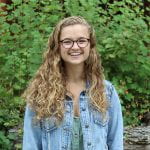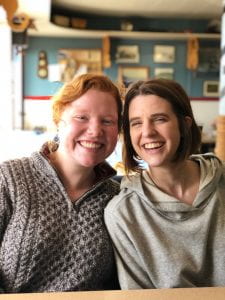By Hannah Fuller, Community Food Systems Coordinator, Oregon State University Extension Service – Wasco County
I was already in my food-demo-routine when I pulled into the Grocery Outlet parking lot in The Dalles. It was late on a Tuesday morning and I was running later than I preferred. It was 11:45, I reminded myself, and I told them I’d be set up by noon. If I worked efficiently, I’d be able to keep my promise and be ready on time. It was only two months into my term of service, but I was already in rhythm of my work with Food Hero and Oregon State University Extension Service in Wasco County. Showcasing different healthy recipes at food bank s, grocery stores and farmers markets is a big part of my job, and I have settled into it quickly. It is one of my favorite ways to engage with my community.
s, grocery stores and farmers markets is a big part of my job, and I have settled into it quickly. It is one of my favorite ways to engage with my community.
This particular Tuesday was a bit different. “Oh hello there!” I heard someone call out from behind my car, “there’s a whole crowd in there waiting for ya!” stopped and turned, he couldn’t be talking to me could he?
I looked at the man who was smiling right at me. He was definitely talking to me.
I recognized the man from a meeting two weeks earlier—the kick-off event of a new pilot program with Mid-Columbia Medical Center, called Food for Life. He is the husband of a woman with diabetes who was picked for the program to receive boxes of healthy food every other week from Grocery Outlet. This was the first week of the pick-up and I’d agreed to plan my food demos to correspond with their times to pick up the boxes at the grocery store.
While I’d settled into my demo routine in the previous weeks, I’d learned some tricks to make things easier for myself. I’d usually pre-cook a lot of the food, and make sure that I was set-up way before people arrived, so I had plenty of time to appear calm and collected before a pantry opened or a market started. It was clear that these Food for Life folks were going to push me to break out of my comfort zone as soon as I pulled into the parking lot.
He helped me unpack my car and wheel in my cart of supplies, a process I usually do by myself, but I accepted his offer to help. When I got to my normal demo spot there was a crowd—not the 100 people my catastrophizing brain imagined, but it was a crowd. I began to set up and chat with the people around me. They are all in the program because they have diabetes and are having trouble managing it because they also suffer from food insecurity. It makes sense that you’d have trouble managing a diet related illness if you can’t afford to eat a healthy diet, right? It’s a logical connection but one that has often gone unnoticed in the medical field. They were chatty and full of energy about their new boxes, full of recipes and m eal guides to help them cook more and feel healthier.
eal guides to help them cook more and feel healthier.
They were laughing, I was freaking out inside. I was trying to remember how to set up an electric skillet, make sure I was following all my food safety protocols, and not missing a step in the recipe, all while talking to a bunch of people watching my every move! Over time I began to relax. I chopped an onion and my eyes began to water and they all laughed with me. They watched closely as I showed them a technique to save them time while cutting, while also keeping their fingers out of the way of the knife. I accidentally added garlic a step late, but it became an opportunity to talk about how flexible recipes can be. Rather than being paralyzed by not planning every step of my demo, their excitement and understanding showed me how much more rewarding it is to be flexible and authentic in m y work.
y work.
Now, rather than putting on a cooking “show” when I do my demos, I really cook with people. They tell me stories about cooking at home and we talk about food as the recipe comes together. As we do this, they get excited about trying new things and more interested in the vegetable heavy recipes I show up with. Every day that I think I have become comfortable in my RARE experience—someone pushes me a bit beyond my comfort zone. Whether it’s the Food for Life patients that get sassy with me when I suggest putting vegetables in a quesadilla, or the facilitators at training that ask me to think more deeply about diversity, equity and inclusion—my RARE year is all about growth.
Lucky for me, I’m here to work, but I’m also here to learn. Professional development is a core part of our service year, and already I’ve been able to take Spanish classes, go to conferences and read amazing books that help me be a better employee and person. Whenever I indicate I have space I want to grow or there’s a topic I want to learn more about, I have the support of my supervisor, the RARE staff and my cohort pushing me along the way. The people I work with in my community show me how rewarding it is to grow and give more of myself, and my program makes it all possible.
About the Author, Hannah Fuller: Hannah recently graduated from Cornell University with a dual-BS in Plant Sciences and International Agriculture & Rural Development, with a minor in Community Food Systems. She spent the last 8 years away from Oregon going to school in New Hampshire and New York, and is thrilled to be back in her home state to serve with the RARE Program in The Dalles. You can usually find her on a run in the Gorge, deep in a new book, or getting in the dirt in her garden.
Does community development work interest you? Are you looking for a life changing experience in rural Oregon? Learn more about serving with the RARE AmeriCorps Program via our website: https://rare.uoregon.edu/application-process/member-application-process





